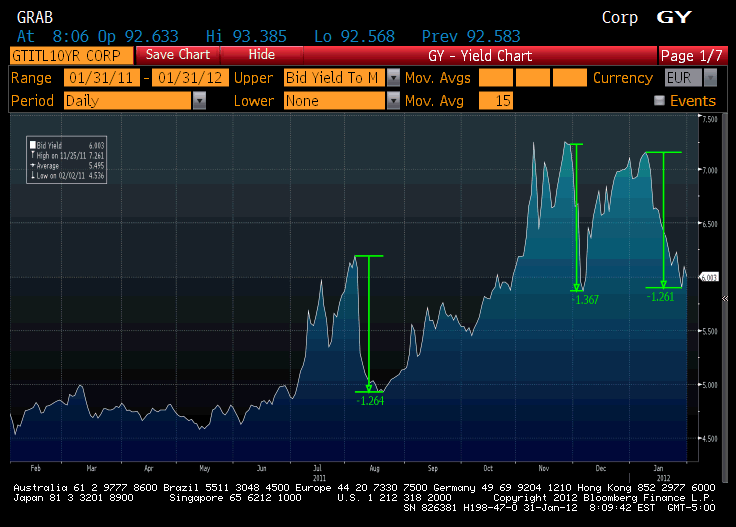The Market Says CYA LTRO To Yesterday’s Negativity
The market is back to being excited and bullish.
Yesterday’s announcement out of Europe was underwhelming, but no one cares as a Greek PSI announcement is expected any moment. It will be interesting to finally find out how many bonds sign on at the time of the agreement and who the potential holdouts are.
More importantly, once again LTRO is the talk of the town. Talk is that the demand will be €1 trillion or more. It will be interesting to see if the number approaches that or is far smaller. I continue to believe that banks are using it to prefund redemptions and not as cheap financing to start a new round of asset gathering. All the talk about the “carry” trade makes it sound like something new that the banks have just figured out, when it is the exact trade that got them in trouble in the first place. Why did banks sell naked CDS on companies and countries (write protection)? Because they got carry with no funding worries.
At least on LTRO we will get a definitive answer soon. How much money do the banks need to pre-fund redemption, how much will they take down to have money available for a rainy day, and most importantly, how much do they take down to invest in new assets?
LTRO without a doubt has been positive for bank funding costs. It is letting them redeem existing bonds as they come due and possibly even helping them opportunistically retire other debt at a discount. Retiring bonds at a discount is an increase to earnings that won’t do much for share price, but does increase “retained capital” so helps the capital ratio of banks. Buying back subordinated debt is also “capital” enhancing, as the discount comes back as capital. Retiring Tier I or other “quasi debt” that counted as capital in the first place is less obvious. That level of capital is reduced while enhancing equity, so some ratios will improve, others may get worse. In any case all of these activities do subordinate any remaining debt. All the outstanding debt is subordinated to the LTRO since it is secured financing. Right now, in the glow of LTRO, no one cares, but any residual sub debt should be viewed very carefully as it is below the depositors, below the LTRO, below the ECB in general, and below senior unsecured debt. And in the weird world of Europe, somehow they seem to want to treat debt with less than a year to maturity as “safer” than longer dated debt.
I am told I am wrong, at least in part because “how could sovereign debt be trading so well if it wasn’t for the LTRO and carry trade”?
Well, this is the 3rd time in less than a year that Italian 10 year bond yields have improved by 125 bps or more in a short period of time. The first such move tighter was after revised EFSF was announced and Italy was added to the SMP. The second such move was after the “Grand Plan” was announced. The third time was late in the year after LTRO and some better auctions. The point is that moves of 125 bps aren’t that uncommon and aren’t a clear sign that LTRO is working. What is clear is that the markets are thin, easily manipulated, or scared into big moves, but once the catalyst for that move is gone (ECB gets tired of buying, nothing from Grand Plan works, or LTRO is about prefunding debt not buying more bonds) the market has returned to focusing on deteriorating fundamentals.
I have been told that the Credit Index Trading 101 piece is scarily accurate about how the credit markets trade. If you haven’t read it, I recommend it. It is partially tongue in cheek but will help you understand why you need to be careful when looking at moves in the credit markets.

